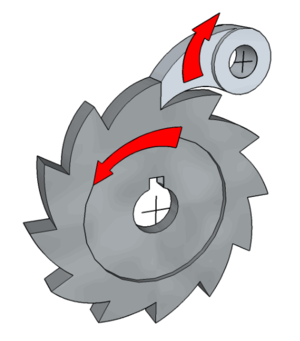Ratchet: Difference between revisions
From DT Online
(Added animation) |
(Added Template and Animation) |
||
| Line 1: | Line 1: | ||
[[File:RatchetPawl.png|300px|right]] | [[File:RatchetPawl.png|300px|right]] | ||
__TOC__ | |||
=====Description===== | |||
A [https://en.wikipedia.org/wiki/Ratchet_%28device%29 '''Ratchet'''] mechanism allows movement in one direction only. | A [https://en.wikipedia.org/wiki/Ratchet_%28device%29 '''Ratchet'''] mechanism allows movement in one direction only. | ||
=====Features and Applications===== | |||
In the illustration, the '''Ratchet Wheel''' lifts the '''Pawl''' as it rotates anti-clockwise but clockwise rotation is stopped by it. Such a system is used in '''[[Windlass|Winches]]''' to allow loads to be lifted up without slipping down again. The '''Ratchet Wheel''' could be fixed to the '''Winch''' shaft via a '''[[Keys, Keyways and Splines|Key]]''' as shown. Alternatively, use of a square or hexagonal winch shaft would ensure it rotates with the '''Ratchet'''. | In the illustration, the '''Ratchet Wheel''' lifts the '''Pawl''' as it rotates anti-clockwise but clockwise rotation is stopped by it. Such a system is used in '''[[Windlass|Winches]]''' to allow loads to be lifted up without slipping down again. The '''Ratchet Wheel''' could be fixed to the '''Winch''' shaft via a '''[[Keys, Keyways and Splines|Key]]''' as shown. Alternatively, use of a square or hexagonal winch shaft would ensure it rotates with the '''Ratchet'''. | ||
| Line 7: | Line 14: | ||
A similar idea can be used to create a '''Linear Ratchet''' which allows motion in one direction but not the other. A '''Pawl''' type mechanism allows each squeeze of a trigger to tighten a '''[[Bar Clamp]]''' for example. They are found also as '''Quick Release Mechanisms''' on some '''[[Carpenters Vice|Wood VIces]]''' and are the basis of the humble [https://en.wikipedia.org/wiki/Cable_tie '''Cable Tie'''], | A similar idea can be used to create a '''Linear Ratchet''' which allows motion in one direction but not the other. A '''Pawl''' type mechanism allows each squeeze of a trigger to tighten a '''[[Bar Clamp]]''' for example. They are found also as '''Quick Release Mechanisms''' on some '''[[Carpenters Vice|Wood VIces]]''' and are the basis of the humble [https://en.wikipedia.org/wiki/Cable_tie '''Cable Tie'''], | ||
=====Animations===== | |||
{| | {| | ||
|- | |- | ||
| | | '''[[2100 Animated Mechanical Mechanisms|Nguyen Duc Thang's]]''' example of a [https://youtu.be/rKYTr9NjgOA '''Ratchet Wheel'''] - ratchet wheel can rotate only anticlockwise because reverse rotation is prevented by flat spring. | ||
| {{#ev:youtube|rKYTr9NjgOA|240x240|right||frame|loop=1&autoplay=1&playlist=rKYTr9NjgOA}} | |||
|- | |||
| '''[[2100 Animated Mechanical Mechanisms|Nguyen Duc Thang's]]''' example of a [https://youtu.be/V4yxGR4d7l8 '''Ratchet Mechanism'''] being used to convert the continuous rotary motion of a drive shaft into the intermittent rotary motion of a driven shaft such that by flicking over the blue pawl the motion direction of the driven shaft can be changed without changing the input motion direction | |||
| {{#ev:youtube|V4yxGR4d7l8|240x240|right||frame|loop=1&autoplay=1&playlist=V4yxGR4d7l8}} | | {{#ev:youtube|V4yxGR4d7l8|240x240|right||frame|loop=1&autoplay=1&playlist=V4yxGR4d7l8}} | ||
|- | |||
| '''[[2100 Animated Mechanical Mechanisms|Nguyen Duc Thang's]]''' example of a [https://youtu.be/fC8D_KzMGrk '''Pendulum Clock Escapment'''] - the gravity pendulum performs a '''[[Types of Motion|harmonic angular oscillation]]''' and the ratchet wheel tends to rotate clockwise due to the weight which is suspended by a cord wound around its shaft. The anchor rocks with the pendulum and allows the wheel to rotate only two teeth during each oscillation - the characteristic ‘Tick-tock’ sound is caused when the anchor collides the wheel teeth. The mechanism is used in pendulum clocks where the wheel motion is transmitted to hands through a gear train to show time. Note that the weight driven wheel also transfers energy to the pendulum ''(timekeeper)'' to replace the energy lost to friction during its cycle and keeps the pendulum oscillating. | |||
| {{#ev:youtube|fC8D_KzMGrk|240x240|right||frame|loop=1&autoplay=1&playlist=fC8D_KzMGrk}} | |||
|} | |} | ||
{{Mechanisms Buyers Guide}} | |||
[[Category:Mechanisms]] | [[Category:Mechanisms]] | ||
Revision as of 08:09, 26 August 2016
Description
A Ratchet mechanism allows movement in one direction only.
Features and Applications
In the illustration, the Ratchet Wheel lifts the Pawl as it rotates anti-clockwise but clockwise rotation is stopped by it. Such a system is used in Winches to allow loads to be lifted up without slipping down again. The Ratchet Wheel could be fixed to the Winch shaft via a Key as shown. Alternatively, use of a square or hexagonal winch shaft would ensure it rotates with the Ratchet.
A similar idea can be used to create a Linear Ratchet which allows motion in one direction but not the other. A Pawl type mechanism allows each squeeze of a trigger to tighten a Bar Clamp for example. They are found also as Quick Release Mechanisms on some Wood VIces and are the basis of the humble Cable Tie,
Animations
| Nguyen Duc Thang's example of a Ratchet Wheel - ratchet wheel can rotate only anticlockwise because reverse rotation is prevented by flat spring. | |
| Nguyen Duc Thang's example of a Ratchet Mechanism being used to convert the continuous rotary motion of a drive shaft into the intermittent rotary motion of a driven shaft such that by flicking over the blue pawl the motion direction of the driven shaft can be changed without changing the input motion direction | |
| Nguyen Duc Thang's example of a Pendulum Clock Escapment - the gravity pendulum performs a harmonic angular oscillation and the ratchet wheel tends to rotate clockwise due to the weight which is suspended by a cord wound around its shaft. The anchor rocks with the pendulum and allows the wheel to rotate only two teeth during each oscillation - the characteristic ‘Tick-tock’ sound is caused when the anchor collides the wheel teeth. The mechanism is used in pendulum clocks where the wheel motion is transmitted to hands through a gear train to show time. Note that the weight driven wheel also transfers energy to the pendulum (timekeeper) to replace the energy lost to friction during its cycle and keeps the pendulum oscillating. |








